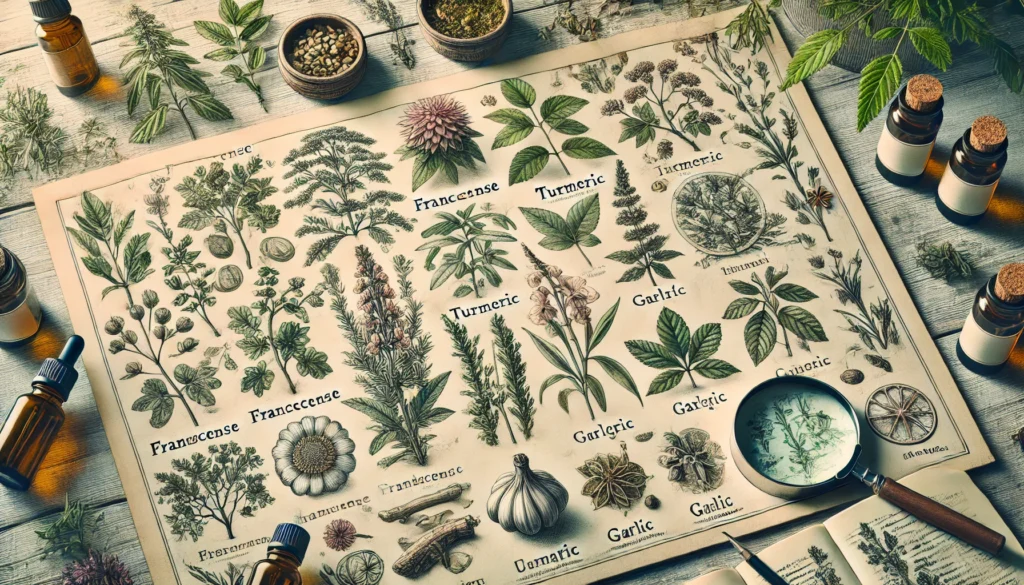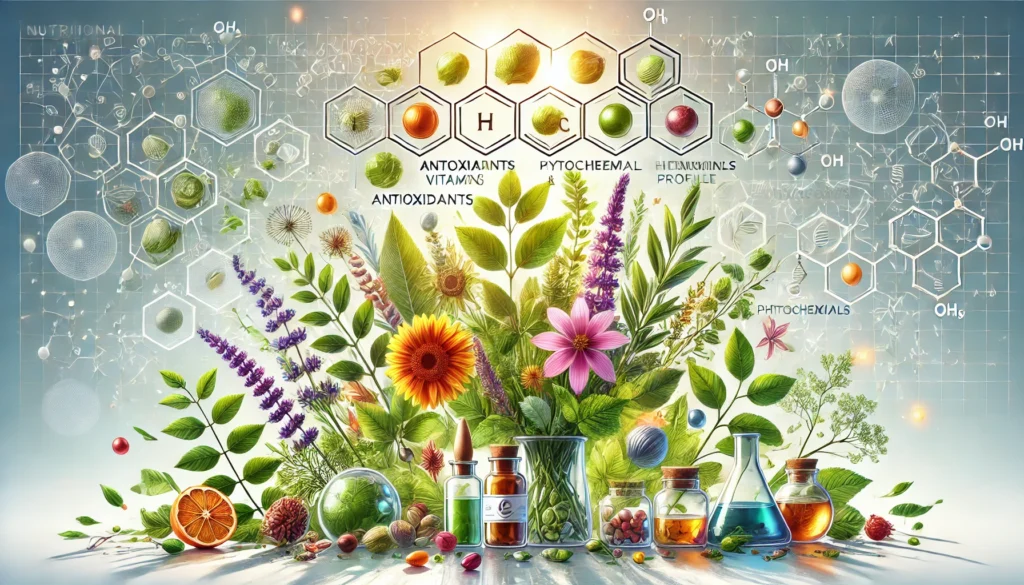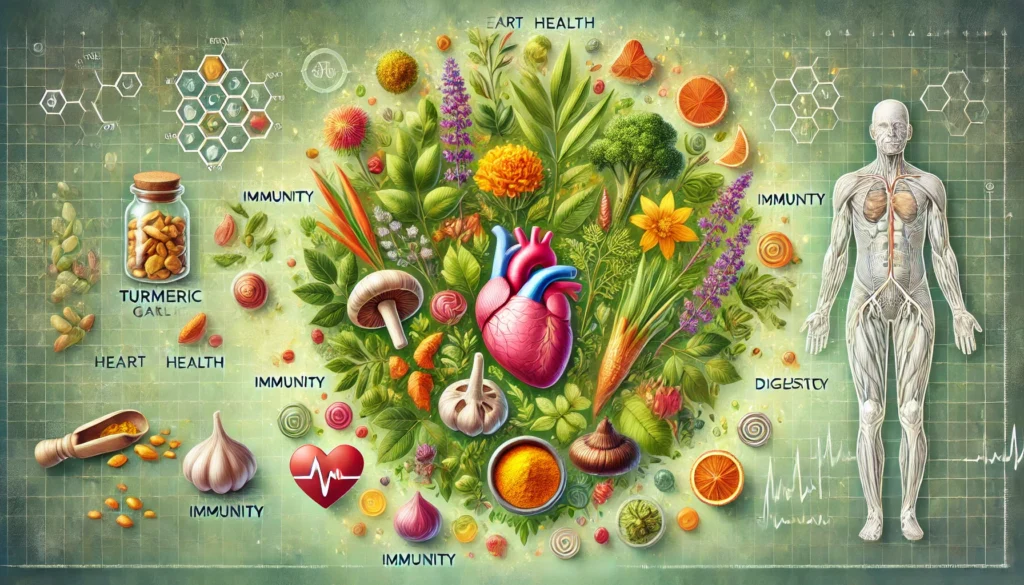Table of Contents
Cayenne Pepper: A Hot Spice with Powerful Health Benefits
Cayenne pepper, known for its fiery heat and vibrant red color, is more than just a flavorful spice. Used for thousands of years for both culinary and medicinal purposes, this pepper offers a host of health benefits that go far beyond the kitchen. From boosting metabolism and improving digestion to relieving pain and promoting heart health, cayenne pepper is a versatile natural remedy that has stood the test of time.
In this blog, we’ll explore the rich history of cayenne pepper, its nutritional and phytochemical profile, its impressive array of health benefits, and the various ways you can incorporate it into your daily life. We’ll also cover some important precautions to keep in mind to ensure you use this potent spice safely.
This site contains affiliate links, and I may receive a commission on purchases made through them. Please see our Affiliate Disclosure for more details.

Historical Significance
Ancient Origins
Cayenne pepper, scientifically known as Capsicum annuum, has a rich history that stretches back thousands of years. Native to the tropical regions of Central and South America, cayenne was a staple in the diets and traditional medicine practices of indigenous cultures, including the Aztecs and Mayans. These early civilizations recognized the powerful effects of cayenne, using it not only to add flavor and heat to their food but also for its medicinal properties.
The indigenous peoples of the Americas used cayenne pepper to treat a variety of ailments. It was used topically for muscle and joint pain, and internally to treat digestive issues, respiratory problems, and circulatory disorders. The ancient Mayans even used cayenne pepper in ceremonial rituals, believing that it had spiritual significance and could purify the body and mind.
Spread to Europe
Cayenne pepper’s journey beyond the Americas began with the arrival of Spanish and Portuguese explorers in the 15th and 16th centuries. After Columbus’s expeditions, cayenne was brought back to Europe, where it quickly gained popularity as both a spice and a medicine. As Europeans explored new trade routes, they introduced cayenne pepper to other parts of the world, including Asia and Africa, where it became a key ingredient in local cuisines and traditional medicine practices.
Cultural Uses
In India, cayenne pepper was embraced by Ayurvedic practitioners, who valued its ability to improve digestion and circulation. It was often combined with other herbs and spices to create potent remedies for various ailments. Similarly, in Chinese medicine, cayenne was used to stimulate blood flow and reduce inflammation, making it a popular treatment for arthritis and other chronic conditions.
Global Cultivation
Today, cayenne pepper is grown and used around the world. It is a staple in cuisines from Mexico and the Caribbean to India, Southeast Asia, and beyond. Cayenne peppers are cultivated in many countries, including India, China, Mexico, and the United States, and they are prized for their intense heat and rich flavor. Whether in fresh, dried, or powdered form, cayenne pepper continues to be one of the most versatile and widely used spices globally.

Botanical Profile
Plant Overview
Cayenne pepper comes from the Capsicum annuum species, part of the nightshade family, which also includes bell peppers, jalapeños, and other chili peppers. The cayenne plant is a perennial shrub that grows to about 2-4 feet in height, producing long, slender peppers that are typically 3 to 5 inches in length. The peppers are green when unripe but turn bright red as they mature, which is when they are most commonly harvested.
The cayenne pepper’s signature heat comes from its concentration of capsaicin, a bioactive compound that stimulates sensory neurons and creates the burning sensation associated with spicy foods. Despite this heat, cayenne is commonly used in both fresh and dried forms in various culinary and medicinal applications.
Growing Conditions
Cayenne peppers thrive in warm, sunny climates and require well-drained soil. They are typically grown in tropical and subtropical regions, although they can also be cultivated in more temperate zones with the right care. The plants are relatively low-maintenance, requiring regular watering and exposure to plenty of sunlight. In some regions, cayenne peppers are grown year-round, while in others, they are planted in the spring and harvested in late summer or early fall.
Different Varieties
While “cayenne” is often used as a generic term, there are several varieties of cayenne peppers, each with its own unique flavor profile and heat level. The most common variety is Red Cayenne, which is known for its bright red color and moderate heat. Other varieties include Yellow Cayenne, which is slightly milder in flavor, and Golden Cayenne, which has a sweet, almost fruity taste along with its spicy kick. The heat of cayenne peppers can vary depending on the variety, but they typically measure between 30,000 to 50,000 Scoville Heat Units (SHU), placing them in the medium-to-hot range.

Nutritional and Phytochemical Profile
Nutritional Content
Cayenne pepper is not just about heat—it’s also packed with nutrients. One tablespoon of cayenne pepper contains:
- Vitamin A: Cayenne is a rich source of vitamin A, providing over 40% of the recommended daily intake in just one tablespoon. Vitamin A is essential for maintaining healthy vision, skin, and immune function.
- Vitamin C: Cayenne is also high in vitamin C, which plays a crucial role in immune health, skin repair, and the absorption of iron from plant-based foods.
- Vitamin E: This antioxidant helps protect cells from damage caused by free radicals and supports skin and immune health.
- Potassium: Cayenne pepper provides a good dose of potassium, an important mineral for maintaining heart health and regulating blood pressure.
- Manganese: Manganese supports bone health, wound healing, and metabolism.
- B Vitamins: Cayenne is a good source of B vitamins like riboflavin and niacin, which help convert food into energy and support overall cellular function.
Phytochemicals
The most potent health-promoting compounds in cayenne pepper are its phytochemicals, particularly capsaicin.
- Capsaicin: This compound is responsible for the spicy heat of cayenne and provides numerous health benefits, from boosting metabolism to relieving pain. Capsaicin is a powerful anti-inflammatory agent, and its ability to stimulate circulation has made it a popular ingredient in topical pain relief creams and patches.
Other Active Compounds
In addition to capsaicin, cayenne contains several other beneficial compounds:
- Flavonoids: These plant-based antioxidants help protect the body from oxidative stress and reduce inflammation.
- Carotenoids: Including beta-carotene, these compounds are converted into vitamin A in the body and support eye health and immune function.
- Saponins: Known for their antioxidant and anti-inflammatory properties, saponins help support heart health and may protect against certain chronic diseases.

Health Benefits of Cayenne Pepper
Cayenne pepper’s combination of vitamins, minerals, and bioactive compounds make it a powerful health booster. Here are some of the most notable benefits:
Boosts Metabolism
Capsaicin is well-known for its metabolism-boosting properties. When consumed, capsaicin increases thermogenesis, the process by which the body produces heat by burning calories. This effect helps the body burn more calories, even at rest, making cayenne pepper a popular ingredient in weight loss supplements and fat-burning formulas.
Studies have shown that consuming capsaicin can increase energy expenditure and fat oxidation, making it a valuable tool for those looking to manage their weight. One study published in the American Journal of Clinical Nutrition found that participants who consumed capsaicin burned more calories and had reduced appetite compared to those who didn’t consume it.
Improves Digestion
Cayenne pepper stimulates the production of digestive enzymes, which helps improve digestion and prevent issues like indigestion and bloating. It also promotes the production of saliva, an important factor in the initial stages of digestion. By increasing enzyme production and reducing bloating, cayenne supports a healthy digestive system.
Capsaicin also helps protect the stomach lining by stimulating mucus production, which can prevent or reduce the risk of ulcers. It has even been shown to help kill harmful bacteria like Helicobacter pylori, which is associated with peptic ulcers and digestive disorders.
Pain Relief
Capsaicin is often used in topical pain relief products to treat conditions like arthritis, muscle pain, and nerve pain (neuropathy). When applied to the skin, capsaicin reduces pain by depleting substance P, a neurotransmitter responsible for transmitting pain signals to the brain. This makes it an effective treatment for chronic pain conditions, including osteoarthritis and rheumatoid arthritis.
Studies have demonstrated that capsaicin creams can significantly reduce pain levels in patients with conditions like diabetic neuropathy and post-herpetic neuralgia (shingles-related pain).
Supports Heart Health
Cayenne pepper supports heart health in several ways. Capsaicin has been shown to help lower blood pressure by relaxing blood vessels and improving circulation. Additionally, cayenne can help reduce LDL (bad) cholesterol levels, prevent blood clots, and lower the risk of heart disease. Its ability to improve circulation also means that cayenne may help reduce the risk of strokes and other cardiovascular issues.
A study published in the Journal of Agriculture and Food Chemistry found that capsaicin helped lower cholesterol levels and prevented plaque buildup in the arteries, further highlighting its role in promoting cardiovascular health.
Anti-inflammatory Properties
Cayenne pepper’s anti-inflammatory effects make it a valuable tool in treating a range of inflammatory conditions. Capsaicin works by blocking certain compounds in the body that cause inflammation, making it helpful for conditions like arthritis, inflammatory bowel disease (IBD), and even chronic pain conditions.
Regular consumption of cayenne may also help reduce the risk of developing chronic diseases associated with inflammation, such as heart disease, diabetes, and cancer.
Immune System Support
Cayenne pepper is rich in vitamin C, a vital nutrient for immune system function. Vitamin C helps boost the production of white blood cells, which are essential for fighting off infections and illnesses. The antioxidant properties of vitamin C also help protect the body from oxidative stress, which can weaken the immune system.
In traditional medicine, cayenne pepper has been used to treat colds, coughs, and sore throats, thanks to its ability to stimulate circulation and clear mucus from the respiratory tract.
Respiratory Health
Cayenne pepper’s ability to clear congestion and support respiratory health makes it an effective remedy for colds, bronchitis, and sinus infections. When consumed, capsaicin helps loosen mucus in the lungs and nasal passages, making it easier to expel. This effect is why cayenne is often included in decongestant formulas and cold remedies.
Weight Loss Aid
In addition to boosting metabolism, cayenne pepper can help reduce appetite, making it easier to manage calorie intake. Studies have shown that capsaicin can help suppress appetite by increasing feelings of fullness and reducing cravings. A study published in the Appetite Journal found that participants who consumed capsaicin had reduced calorie intake and reported feeling fuller after meals.
Detoxification
Cayenne pepper is known for its ability to stimulate circulation and induce sweating, both of which are important for the body’s detoxification process. Sweating helps eliminate toxins from the body, and cayenne’s ability to increase blood flow ensures that oxygen and nutrients are delivered more efficiently to the cells. This detoxifying effect is one reason why cayenne is often included in detox diets and cleansing programs.
Antimicrobial Properties
Cayenne pepper has natural antimicrobial properties that can help kill harmful bacteria and prevent infections. Capsaicin has been shown to inhibit the growth of various strains of bacteria, including E. coli and Salmonella, making cayenne a valuable tool in food preservation and natural remedies.
When applied topically, cayenne pepper can also help prevent skin infections by killing bacteria that cause conditions like acne or wounds.

Methods of Consumption
There are numerous ways to incorporate cayenne pepper into your diet or use it for medicinal purposes:
Fresh and Dried Cayenne Peppers
Fresh cayenne peppers can be used in a variety of dishes, including salsas, marinades, soups, and stews. Their bright red color and spicy kick make them a flavorful addition to both raw and cooked recipes. For those who enjoy heat, cayenne peppers can be sliced and added to salads or used as a garnish.
Cayenne Powder
Cayenne powder is one of the most popular forms of cayenne pepper. It can be used to spice up savory dishes, such as curries, stir-fries, and sauces. Cayenne powder can also be added to teas, smoothies, or detox drinks. Many people enjoy a morning detox drink made with lemon juice, water, and a pinch of cayenne powder to kickstart digestion and metabolism.
Cayenne Supplements
For those who want to experience the health benefits of cayenne without the intense heat, cayenne supplements are a convenient option. These supplements are available in capsule form and are often standardized to contain a specific concentration of capsaicin. Cayenne supplements are typically used to support digestion, metabolism, and heart health.
Topical Creams and Ointments
Capsaicin creams are widely available for pain relief and are commonly used to treat conditions like arthritis, muscle pain, and nerve pain. These creams should be applied directly to the affected area, but it’s important to avoid contact with the eyes, nose, or mouth, as capsaicin can cause irritation.
Cayenne Tinctures
Cayenne tinctures are a concentrated liquid form of cayenne pepper that can be taken orally to support digestion, circulation, and pain relief. A few drops of cayenne tincture can be added to water or tea, providing a quick and easy way to reap the health benefits of cayenne. Tinctures are often used in natural medicine to treat a variety of ailments, from cold symptoms to digestive disorders.

Cautionary Advice
While cayenne pepper offers many health benefits, it’s important to use it with caution, especially if you’re not accustomed to spicy foods or have certain health conditions.
Potential Side Effects
Consuming large amounts of cayenne pepper can cause digestive discomfort, including heartburn, stomach irritation, and diarrhea. If you’re new to cayenne, it’s best to start with small amounts and gradually increase your intake.
Medication Interactions
Cayenne pepper may interact with certain medications, particularly blood thinners like warfarin, as it can increase the risk of bleeding. It may also interact with medications that lower blood pressure or affect circulation. If you are taking any medications, it’s important to consult your healthcare provider before adding cayenne supplements or large amounts of cayenne pepper to your diet.
Allergies
Although rare, some individuals may be allergic to cayenne pepper. Symptoms of an allergic reaction may include itching, swelling, or difficulty breathing. If you experience any of these symptoms after consuming cayenne, discontinue use and seek medical attention.
Topical Use Warnings
Capsaicin creams can cause a burning sensation on the skin, especially if applied to sensitive areas or open wounds. It’s important to wash your hands thoroughly after applying capsaicin creams and avoid contact with the eyes, nose, or mouth. If you experience excessive burning or irritation, discontinue use.
Pregnancy and Nursing
Pregnant or breastfeeding women should consult their healthcare provider before using cayenne supplements or large amounts of cayenne in their diet. While cayenne is generally considered safe in culinary amounts, excessive use of supplements or capsaicin creams may not be recommended during pregnancy.

Conclusion
Cayenne pepper is more than just a spicy addition to your meals—it’s a powerhouse of nutrients and bioactive compounds that offer a wide range of health benefits. From boosting metabolism and improving digestion to relieving pain and supporting heart health, cayenne is a versatile spice that can enhance both your diet and your overall well-being.
Whether you enjoy it fresh, powdered, or in supplement form, cayenne pepper is an excellent natural remedy to include in your health routine. Just be sure to use it safely, especially if you’re new to spicy foods or have any health concerns. With its long history of medicinal use and its modern-day health benefits, cayenne pepper is truly a spice worth embracing.
